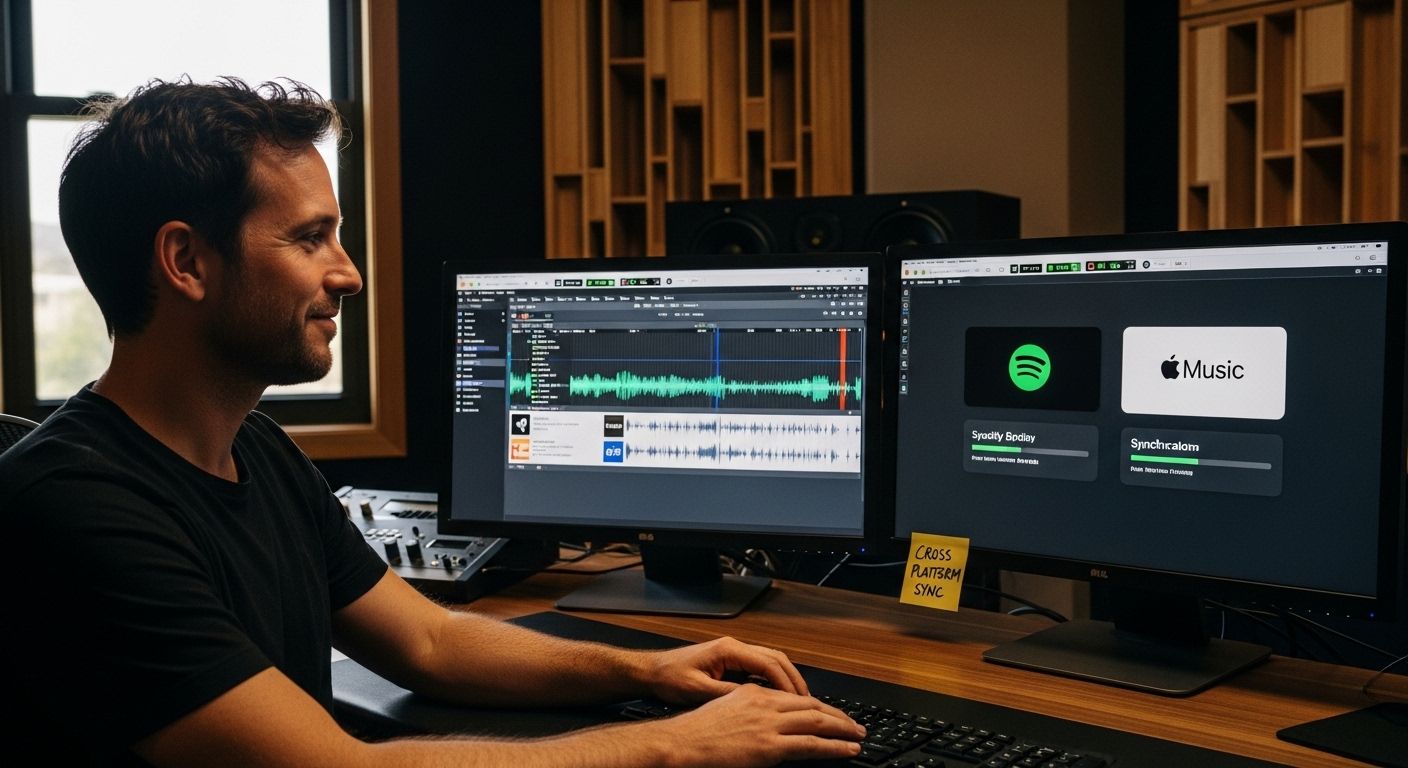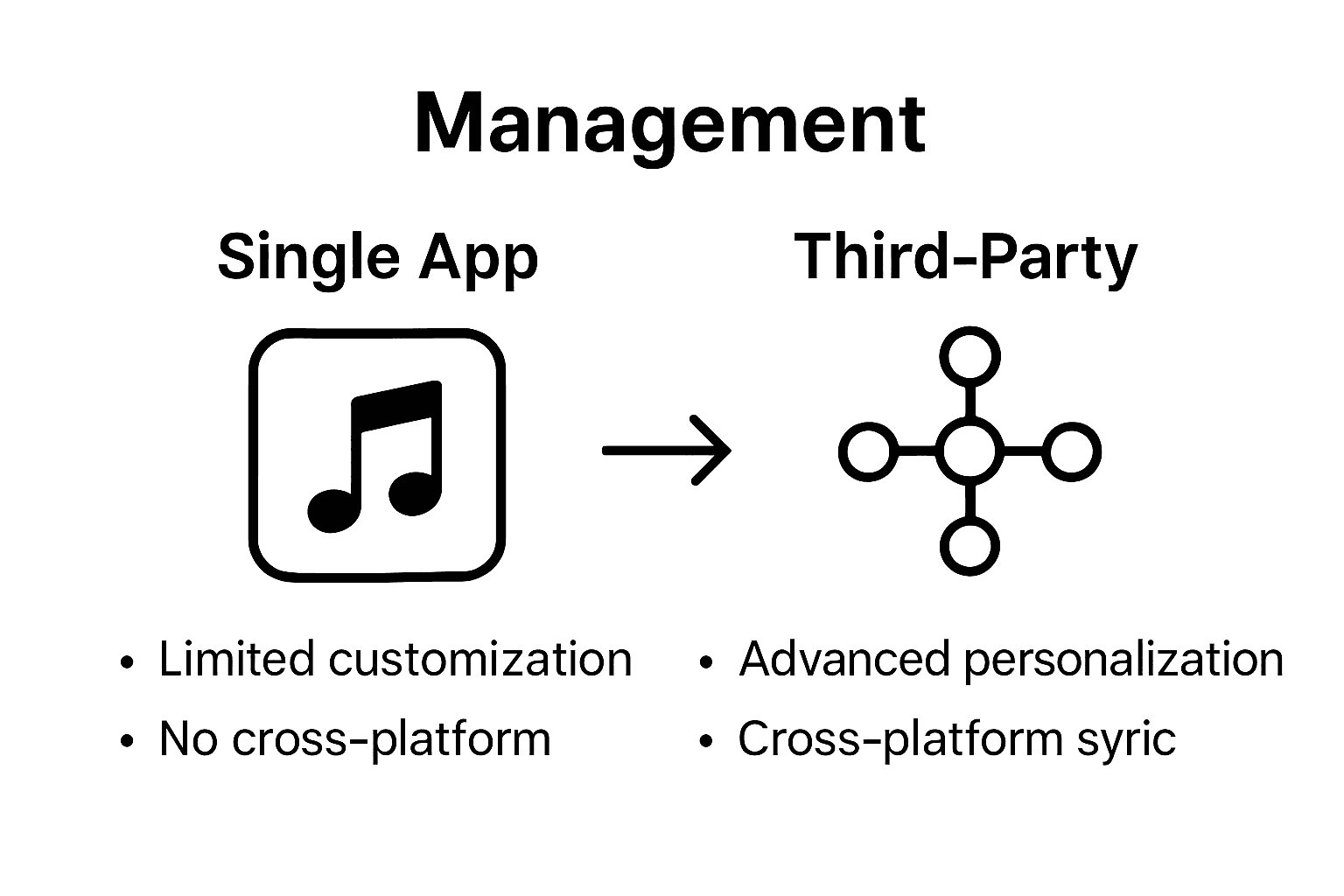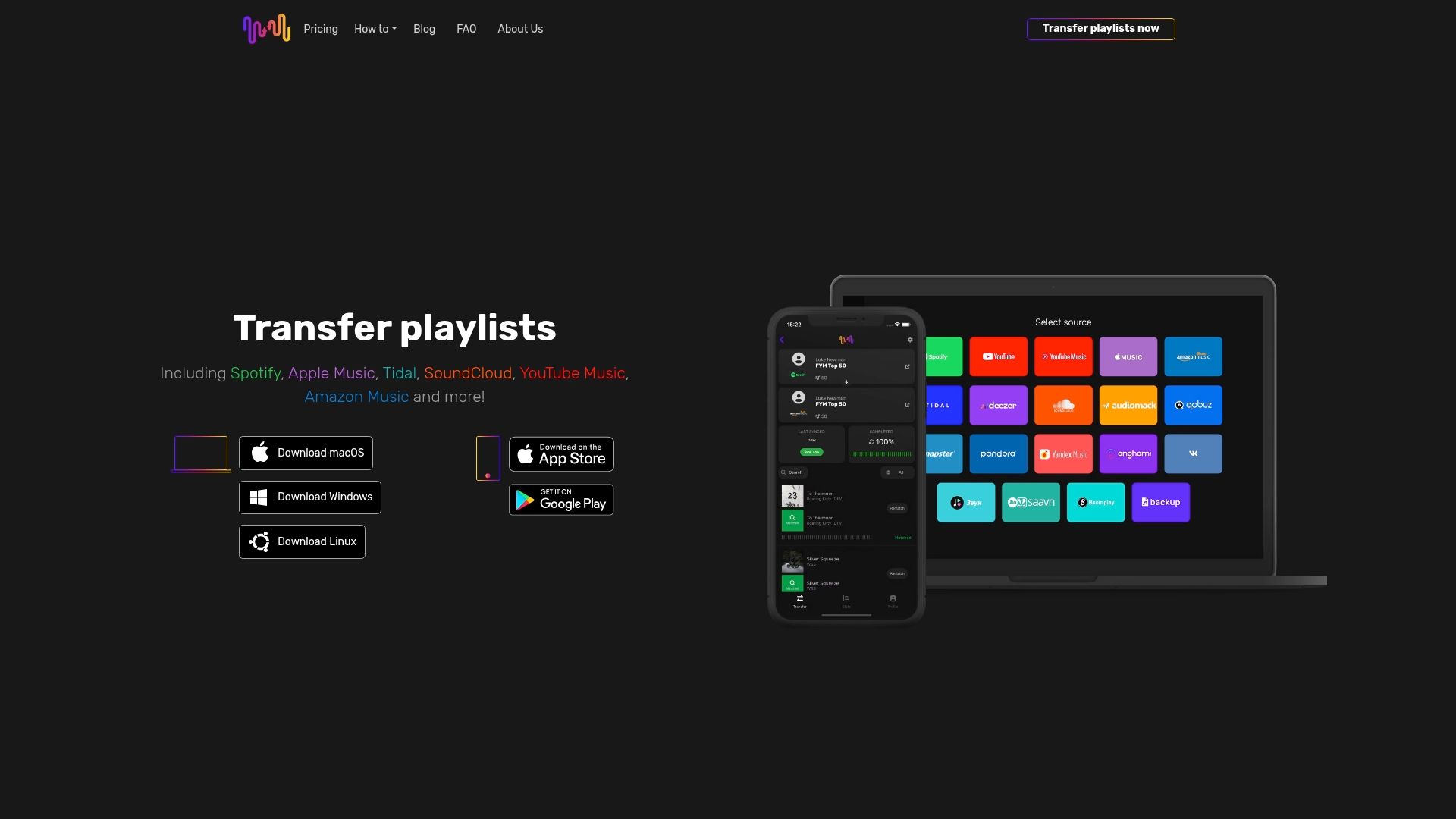Third-party music apps are changing how people listen to and organize their favorite songs. Most users stick to major streaming platforms and assume those features are all there is. Yet, studies show over 60 percent of digital music fans now use at least one third-party app to control their collections across platforms. These hidden tools are not just extra gadgets, they are quietly shaping the future of music streaming.
Table of Contents
- Defining Third-Party Music Apps: What Are They?
- Core Characteristics of Third-Party Music Apps
- Technical Architecture and Functionality
- The Importance of Third-Party Music Apps in Streaming
- Enhanced User Control and Flexibility
- Economic and Technological Implications
- How Third-Party Music Apps Enhance User Experience
- Personalization and Advanced Music Management
- Technical Innovation and User Empowerment
- Key Features and Functions of Popular Third-Party Music Apps
- Advanced Music Library Management
- Cross Platform Integration and Synchronization
- The Future Landscape of Third-Party Music Apps
- Technological Evolution and Advanced Integration
- Expanding Ecosystem and User Empowerment
Quick Summary
| Takeaway | Explanation |
|---|---|
| Third-party apps enhance music experience | They provide features that surpass standard streaming services, offering users more control and customization options. |
| Seamless integration across platforms | These apps allow for effortless syncing of music libraries and playlist transfers between various streaming services. |
| Advanced playlist management tools | Users can create intelligent playlists and manage music libraries effectively, improving overall organization. |
| Empowerment through user control | Third-party apps grant users autonomy to curate their music collections freely, beyond the limitations of individual platforms. |
| Future innovations will enhance functionality | Expect ongoing advancements in AI and machine learning, leading to even more personalized and intelligent music management solutions. |
Defining Third-Party Music Apps: What Are They?
Third-party music apps represent independent software applications designed to enhance and expand the functionality of mainstream music streaming platforms. These innovative tools operate outside the core ecosystem of primary music services, offering users additional capabilities and flexible management options for their digital music collections.
Core Characteristics of Third-Party Music Apps
Unique software applications like third-party music apps fundamentally transform how users interact with their music libraries. Independent research from digital music platforms reveals these applications typically share several defining characteristics:
- Interoperability: Ability to connect and interact across multiple music streaming platforms
- Enhanced Functionality: Providing features beyond standard streaming service capabilities
- User-Driven Customization: Offering personalized music management solutions
These applications leverage Application Programming Interfaces (APIs) from primary music platforms to create seamless integration and expanded user experiences. Whether you are a casual listener or a music professional, third-party music apps can significantly streamline playlist management and music collection organization.
Below is a comparison table summarizing core characteristics that distinguish third-party music apps from standard streaming platforms, enhancing clarity on their unique values for users.
| Characteristic | Description |
|---|---|
| Interoperability | Connects and interacts with multiple streaming platforms |
| Enhanced Functionality | Offers features beyond default streaming service capabilities |
| User-Driven Customization | Provides personalized music and playlist management options |
| Advanced Library Management | Enables complex tasks like playlist transfers and backups across services |
| API Integration | Leverages APIs to integrate with core music platform functionality |
Technical Architecture and Functionality
At their core, third-party music apps function as intermediary software solutions that bridge gaps between different music streaming services. They enable users to perform complex tasks such as transferring playlists, synchronizing libraries, and creating backup collections across multiple platforms.
The technical infrastructure of these apps relies on sophisticated algorithms that can match and transfer songs accurately, preserving metadata, playlist order, and user preferences. By reading more about playlist transfer strategies, users can understand the intricate processes behind these innovative music management tools.
Understanding the role of third-party music apps means recognizing them as powerful extensions of traditional music streaming experiences. They represent a user-centric approach to digital music management, empowering listeners with greater control and flexibility in how they collect, organize, and enjoy their musical libraries.
The Importance of Third-Party Music Apps in Streaming
Third-party music apps have emerged as transformative solutions that address critical challenges in the digital music ecosystem. By providing sophisticated tools beyond standard streaming platform capabilities, these applications have become essential for music enthusiasts seeking more comprehensive and flexible listening experiences.
Enhanced User Control and Flexibility
Research from digital music technology experts demonstrates that third-party music apps significantly expand user autonomy in managing digital music collections. These applications offer unprecedented control mechanisms that traditional streaming platforms cannot match:
- Cross Platform Synchronization: Enabling seamless music library transfers
- Advanced Playlist Management: Creating complex organizational structures
- Personalized Music Experiences: Tailoring listening environments beyond default settings
Users gain the ability to transcend the limitations of individual streaming services, creating more dynamic and personalized music management strategies. The flexibility provided by these apps represents a fundamental shift in how individuals interact with their digital music libraries.
Economic and Technological Implications
Third-party music apps are not merely convenience tools but represent significant technological innovations in the streaming landscape. By exploring playlist transfer strategies, users can understand the complex algorithmic processes that enable intricate music library management.
These applications create economic opportunities by reducing friction between different music platforms. They enable users to explore new services without losing their carefully curated music collections, thus promoting healthy competition and innovation within the streaming ecosystem.
The importance of third-party music apps extends beyond individual user experiences. They represent a critical bridge in the evolving digital music infrastructure, empowering listeners with unprecedented control, flexibility, and technological sophistication in managing their musical journeys.
How Third-Party Music Apps Enhance User Experience
Third-party music apps have revolutionized digital music consumption by introducing sophisticated tools that dramatically improve how users interact with their music libraries. These innovative applications go beyond traditional streaming platform limitations, offering unprecedented levels of customization and control.
Personalization and Advanced Music Management
Digital music consumer research reveals that users increasingly demand more nuanced control over their music collections. Third-party music apps address this need through advanced personalization features:
- Intelligent Playlist Curation: Creating smart playlists based on listening habits
- Comprehensive Metadata Management: Enabling precise track and album organization
- Cross Platform Synchronization: Maintaining music libraries across multiple services
These applications transform music management from a basic storage function into a dynamic, intelligent experience that adapts to individual user preferences and listening patterns.
Technical Innovation and User Empowerment
The technical sophistication of third-party music apps represents a significant leap in user experience design. By developing complex algorithms that can seamlessly transfer and match songs across different platforms, these apps eliminate traditional barriers of music ecosystem fragmentation.
By exploring detailed playlist transfer techniques, users gain insights into the intricate technological processes that make such seamless music management possible. These apps provide users with tools that were previously unavailable, effectively democratizing music library management.
Ultimately, third-party music apps enhance user experience by providing unprecedented flexibility, control, and intelligence in managing digital music collections. They represent a user-centric approach to music technology, prioritizing individual preferences and technological convenience.

Key Features and Functions of Popular Third-Party Music Apps
Third-party music apps have evolved into sophisticated software solutions that extend far beyond basic music playback and storage. These applications offer comprehensive tools designed to transform how users interact with their digital music collections, providing capabilities that traditional streaming platforms cannot match.
Advanced Music Library Management
Research into digital music technologies highlights the sophisticated features that distinguish third-party music apps from standard streaming platforms. These applications deliver unprecedented control and flexibility:
- Comprehensive Metadata Editing: Allowing precise track information modifications
- Smart Playlist Generation: Creating intelligent collections based on listening patterns
- Bulk Music Organization: Enabling large-scale library management and cleanup
Users gain powerful tools that allow deep customization of their music libraries, transcending the limitations of native streaming platform interfaces.
This table organizes key advanced features offered by popular third-party music apps, making it easier to understand how they extend beyond basic streaming platform options.
| Feature | Benefit |
|---|---|
| Comprehensive Metadata Editing | Modify and correct track/album information |
| Smart Playlist Generation | Create playlists based on habits and preferences |
| Bulk Music Organization | Manage and clean up large libraries efficiently |
| Cross-Platform Integration | Seamlessly transfer music between different streaming services |
| Intelligent Song Matching | Maintains playlist order and preserves metadata across migrations |

Cross Platform Integration and Synchronization
One of the most significant advantages of third-party music apps is their ability to bridge gaps between different streaming services. By exploring playlist transfer strategies, users can understand how these applications enable seamless music library migrations.
These apps employ complex algorithms that can accurately match and transfer music across different platforms, preserving crucial metadata like playlists, ratings, and play counts. This functionality eliminates the traditional friction of switching between music streaming services, providing users with unprecedented flexibility.
The key features of third-party music apps represent a technological revolution in digital music management. By offering intelligent, user-centric tools, these applications empower listeners to take complete control of their musical experiences, transforming music consumption from a passive to an actively curated journey.
The Future Landscape of Third-Party Music Apps
The technological trajectory of third-party music apps points toward a transformative future where digital music management becomes increasingly intelligent, personalized, and seamlessly integrated across platforms. These applications are poised to revolutionize how users interact with their musical ecosystems.
Technological Evolution and Advanced Integration
Research into emerging digital music technologies indicates significant developments in third-party music app capabilities. The future landscape will likely feature more sophisticated technological innovations:
- Artificial Intelligence Driven Recommendations: Creating hyper-personalized music experiences
- Advanced Interoperability: Seamless connections across multiple streaming platforms
- Enhanced Machine Learning Algorithms: Predicting and adapting to user listening preferences
These technological advancements suggest a future where music apps become more than simple management tools, transforming into intelligent digital music companions that understand and anticipate user needs.
Expanding Ecosystem and User Empowerment
The next generation of third-party music apps will focus on providing unprecedented user control and flexibility. By exploring advanced playlist transfer techniques, users can glimpse the potential of future music management technologies.
Developers are increasingly prioritizing user-centric design, creating applications that not only transfer music but also provide comprehensive analytics, social sharing capabilities, and cross-platform synchronization. The emerging landscape suggests a future where users have complete autonomy over their digital music collections.
Ultimately, the future of third-party music apps represents a convergence of technological innovation, user experience design, and personalized digital entertainment. These applications are set to redefine how we discover, manage, and enjoy music in an increasingly connected digital world.
Effortless Playlist Transfers: Your Next Step in Seamless Music Management
Struggling to keep your playlists organized as you jump between music services? The article highlighted how third-party music apps give back control and remove the stress that comes with fragmented libraries and manual playlist rebuilding. When maintaining your unique curation feels impossible, especially as you switch providers or want your collection accessible everywhere, you need a smarter, faster solution.

Let Free Your Music turn those complex, time-consuming tasks into a one-click experience. Our platform specializes in fully automated playlist transfers and cross-platform synchronization, no matter which streaming service you use. With accurate song matching, unlimited transfers, and cloud backup, our app guarantees effortless migration without losing your playlists' order or detail. Ready to stop wasting time and start enjoying your music collection without limits? Visit Free Your Music now and move your entire playlist library instantly—because you deserve the freedom to listen your way.
Frequently Asked Questions
What are third-party music apps?
Third-party music apps are independent software applications designed to enhance and expand the functionality of mainstream music streaming platforms, offering additional features and flexible management options for users' digital music collections.
How do third-party music apps enhance user experience?
These apps improve user experience by providing personalized music management features, intelligent playlist curation, and seamless synchronization across multiple streaming services, enabling greater control and customization of music libraries.
What are the key features of popular third-party music apps?
Key features include advanced music library management, comprehensive metadata editing, smart playlist generation, and the ability to transfer music seamlessly between different streaming platforms, preserving crucial data like playlists and play counts.
What is the future of third-party music apps?
The future of third-party music apps will likely involve advancements in artificial intelligence for personalized recommendations, enhanced interoperability between services, and improved user experience design, transforming how users manage and interact with their music collections.






